Applying Innovation Theories to Dyson: A Strategic Report
VerifiedAdded on 2023/01/09
|13
|3795
|73
Report
AI Summary
This report provides a comprehensive analysis of Dyson's innovation strategies, focusing on the application of two key innovation theories: the Diffusion of Innovation (DOI) and the Blue Ocean Strategy. The report begins with an introduction to innovation and its importance for business growth, followed by a detailed explanation of the DOI theory, including its adopter taxonomies and the process of technology adoption. The Blue Ocean Strategy is then introduced, highlighting its principles and contrasting it with traditional competitive models. The main body applies these theories to Dyson's historical development, examining how Dyson has leveraged the DOI to introduce and market its products successfully. The report also explores potential future development pathways for Dyson using the Blue Ocean Strategy, recommending strategies to create uncontested market spaces. The conclusion summarizes the key findings and emphasizes the significance of innovation for Dyson's continued success. The report leverages academic sources to support its claims and recommendations, providing a well-rounded perspective on Dyson's innovation management.
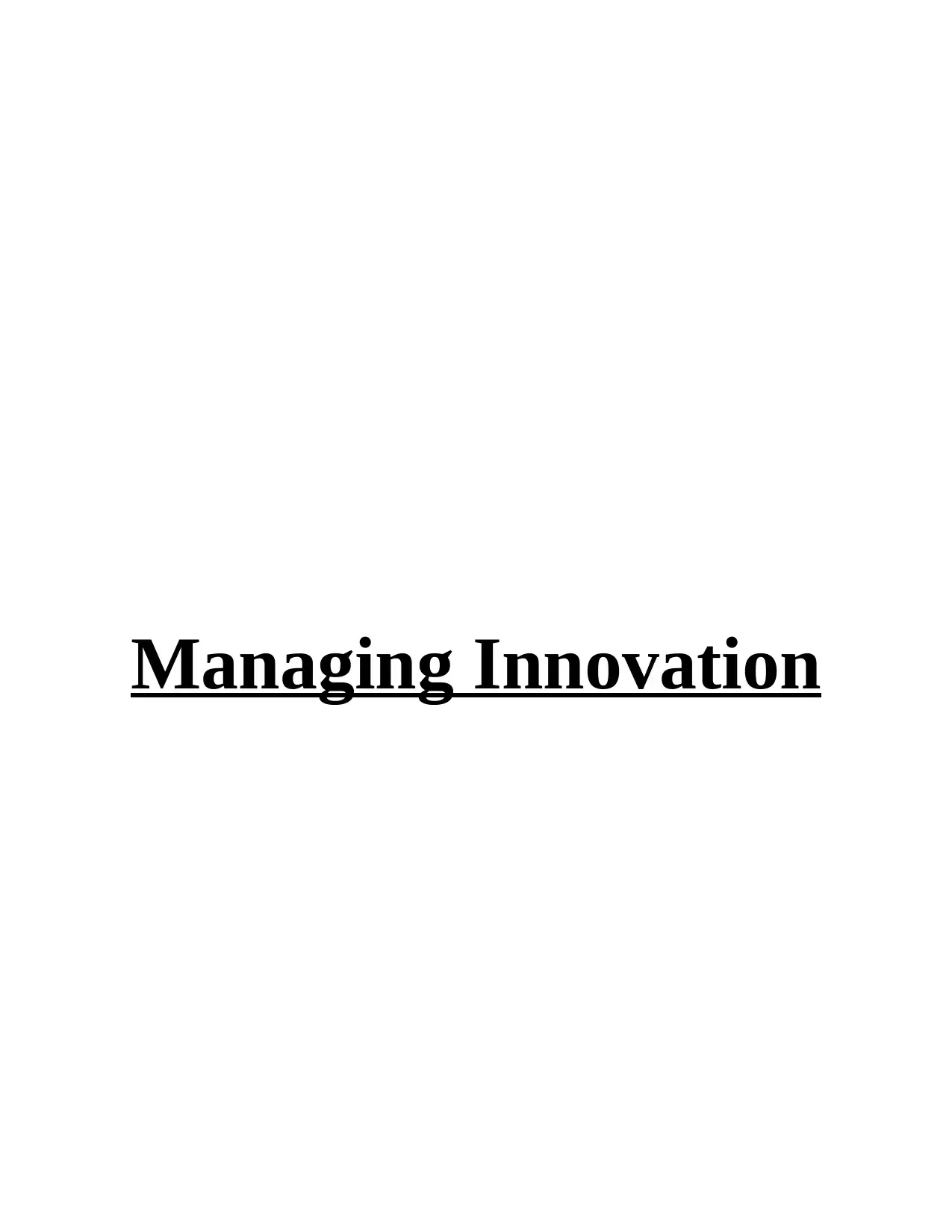
Managing Innovation
Paraphrase This Document
Need a fresh take? Get an instant paraphrase of this document with our AI Paraphraser
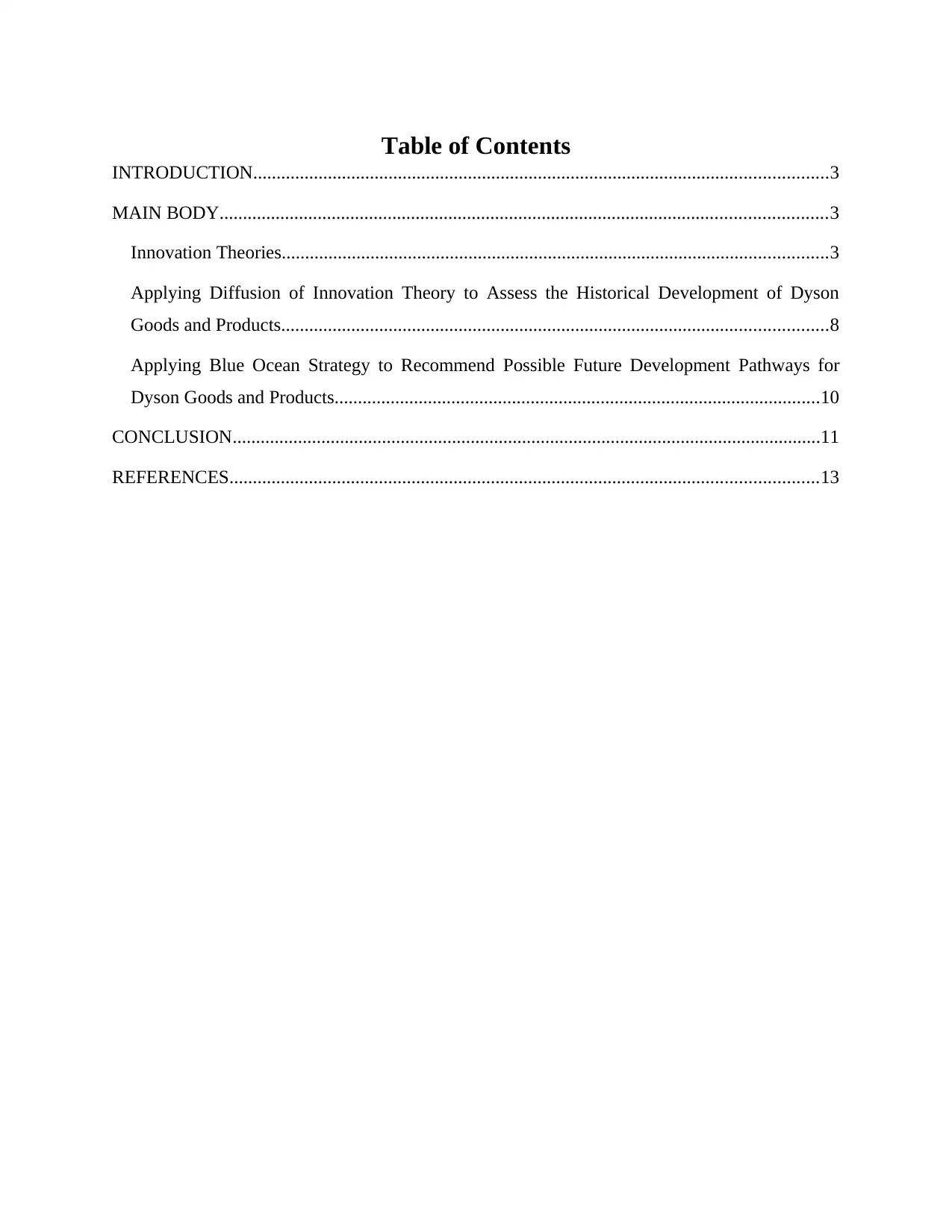
Table of Contents
INTRODUCTION...........................................................................................................................3
MAIN BODY..................................................................................................................................3
Innovation Theories.....................................................................................................................3
Applying Diffusion of Innovation Theory to Assess the Historical Development of Dyson
Goods and Products.....................................................................................................................8
Applying Blue Ocean Strategy to Recommend Possible Future Development Pathways for
Dyson Goods and Products........................................................................................................10
CONCLUSION..............................................................................................................................11
REFERENCES..............................................................................................................................13
INTRODUCTION...........................................................................................................................3
MAIN BODY..................................................................................................................................3
Innovation Theories.....................................................................................................................3
Applying Diffusion of Innovation Theory to Assess the Historical Development of Dyson
Goods and Products.....................................................................................................................8
Applying Blue Ocean Strategy to Recommend Possible Future Development Pathways for
Dyson Goods and Products........................................................................................................10
CONCLUSION..............................................................................................................................11
REFERENCES..............................................................................................................................13
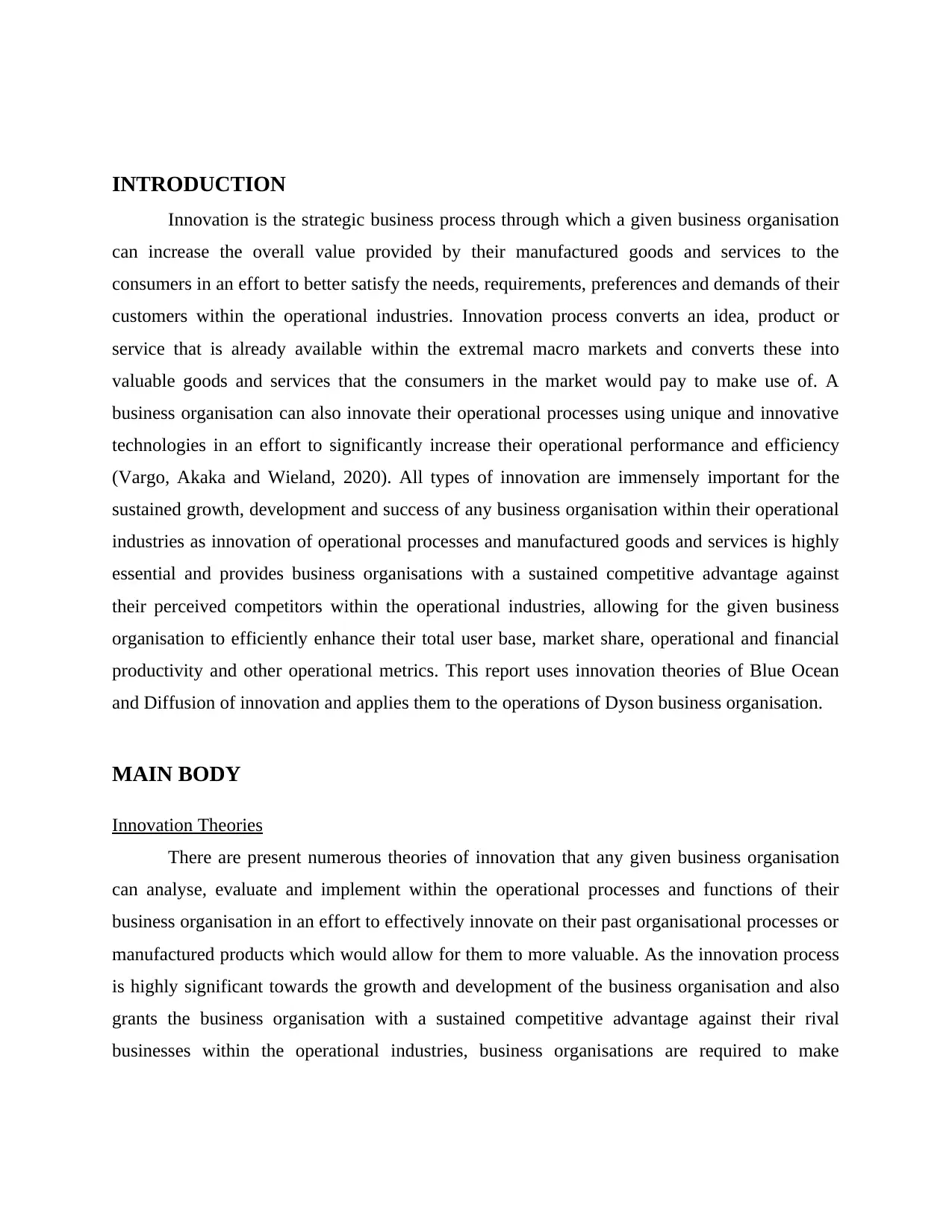
INTRODUCTION
Innovation is the strategic business process through which a given business organisation
can increase the overall value provided by their manufactured goods and services to the
consumers in an effort to better satisfy the needs, requirements, preferences and demands of their
customers within the operational industries. Innovation process converts an idea, product or
service that is already available within the extremal macro markets and converts these into
valuable goods and services that the consumers in the market would pay to make use of. A
business organisation can also innovate their operational processes using unique and innovative
technologies in an effort to significantly increase their operational performance and efficiency
(Vargo, Akaka and Wieland, 2020). All types of innovation are immensely important for the
sustained growth, development and success of any business organisation within their operational
industries as innovation of operational processes and manufactured goods and services is highly
essential and provides business organisations with a sustained competitive advantage against
their perceived competitors within the operational industries, allowing for the given business
organisation to efficiently enhance their total user base, market share, operational and financial
productivity and other operational metrics. This report uses innovation theories of Blue Ocean
and Diffusion of innovation and applies them to the operations of Dyson business organisation.
MAIN BODY
Innovation Theories
There are present numerous theories of innovation that any given business organisation
can analyse, evaluate and implement within the operational processes and functions of their
business organisation in an effort to effectively innovate on their past organisational processes or
manufactured products which would allow for them to more valuable. As the innovation process
is highly significant towards the growth and development of the business organisation and also
grants the business organisation with a sustained competitive advantage against their rival
businesses within the operational industries, business organisations are required to make
Innovation is the strategic business process through which a given business organisation
can increase the overall value provided by their manufactured goods and services to the
consumers in an effort to better satisfy the needs, requirements, preferences and demands of their
customers within the operational industries. Innovation process converts an idea, product or
service that is already available within the extremal macro markets and converts these into
valuable goods and services that the consumers in the market would pay to make use of. A
business organisation can also innovate their operational processes using unique and innovative
technologies in an effort to significantly increase their operational performance and efficiency
(Vargo, Akaka and Wieland, 2020). All types of innovation are immensely important for the
sustained growth, development and success of any business organisation within their operational
industries as innovation of operational processes and manufactured goods and services is highly
essential and provides business organisations with a sustained competitive advantage against
their perceived competitors within the operational industries, allowing for the given business
organisation to efficiently enhance their total user base, market share, operational and financial
productivity and other operational metrics. This report uses innovation theories of Blue Ocean
and Diffusion of innovation and applies them to the operations of Dyson business organisation.
MAIN BODY
Innovation Theories
There are present numerous theories of innovation that any given business organisation
can analyse, evaluate and implement within the operational processes and functions of their
business organisation in an effort to effectively innovate on their past organisational processes or
manufactured products which would allow for them to more valuable. As the innovation process
is highly significant towards the growth and development of the business organisation and also
grants the business organisation with a sustained competitive advantage against their rival
businesses within the operational industries, business organisations are required to make
⊘ This is a preview!⊘
Do you want full access?
Subscribe today to unlock all pages.

Trusted by 1+ million students worldwide
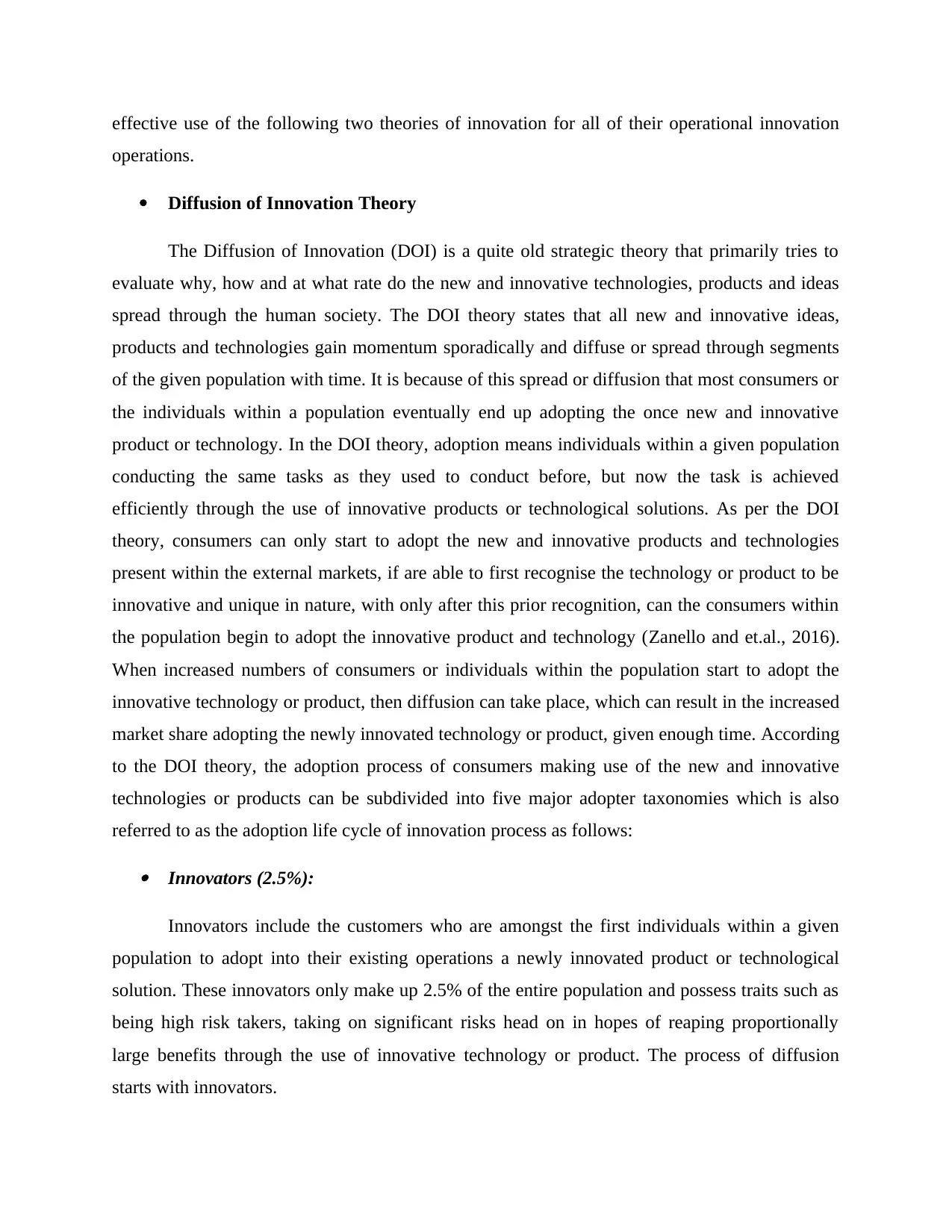
effective use of the following two theories of innovation for all of their operational innovation
operations.
Diffusion of Innovation Theory
The Diffusion of Innovation (DOI) is a quite old strategic theory that primarily tries to
evaluate why, how and at what rate do the new and innovative technologies, products and ideas
spread through the human society. The DOI theory states that all new and innovative ideas,
products and technologies gain momentum sporadically and diffuse or spread through segments
of the given population with time. It is because of this spread or diffusion that most consumers or
the individuals within a population eventually end up adopting the once new and innovative
product or technology. In the DOI theory, adoption means individuals within a given population
conducting the same tasks as they used to conduct before, but now the task is achieved
efficiently through the use of innovative products or technological solutions. As per the DOI
theory, consumers can only start to adopt the new and innovative products and technologies
present within the external markets, if are able to first recognise the technology or product to be
innovative and unique in nature, with only after this prior recognition, can the consumers within
the population begin to adopt the innovative product and technology (Zanello and et.al., 2016).
When increased numbers of consumers or individuals within the population start to adopt the
innovative technology or product, then diffusion can take place, which can result in the increased
market share adopting the newly innovated technology or product, given enough time. According
to the DOI theory, the adoption process of consumers making use of the new and innovative
technologies or products can be subdivided into five major adopter taxonomies which is also
referred to as the adoption life cycle of innovation process as follows:
Innovators (2.5%):
Innovators include the customers who are amongst the first individuals within a given
population to adopt into their existing operations a newly innovated product or technological
solution. These innovators only make up 2.5% of the entire population and possess traits such as
being high risk takers, taking on significant risks head on in hopes of reaping proportionally
large benefits through the use of innovative technology or product. The process of diffusion
starts with innovators.
operations.
Diffusion of Innovation Theory
The Diffusion of Innovation (DOI) is a quite old strategic theory that primarily tries to
evaluate why, how and at what rate do the new and innovative technologies, products and ideas
spread through the human society. The DOI theory states that all new and innovative ideas,
products and technologies gain momentum sporadically and diffuse or spread through segments
of the given population with time. It is because of this spread or diffusion that most consumers or
the individuals within a population eventually end up adopting the once new and innovative
product or technology. In the DOI theory, adoption means individuals within a given population
conducting the same tasks as they used to conduct before, but now the task is achieved
efficiently through the use of innovative products or technological solutions. As per the DOI
theory, consumers can only start to adopt the new and innovative products and technologies
present within the external markets, if are able to first recognise the technology or product to be
innovative and unique in nature, with only after this prior recognition, can the consumers within
the population begin to adopt the innovative product and technology (Zanello and et.al., 2016).
When increased numbers of consumers or individuals within the population start to adopt the
innovative technology or product, then diffusion can take place, which can result in the increased
market share adopting the newly innovated technology or product, given enough time. According
to the DOI theory, the adoption process of consumers making use of the new and innovative
technologies or products can be subdivided into five major adopter taxonomies which is also
referred to as the adoption life cycle of innovation process as follows:
Innovators (2.5%):
Innovators include the customers who are amongst the first individuals within a given
population to adopt into their existing operations a newly innovated product or technological
solution. These innovators only make up 2.5% of the entire population and possess traits such as
being high risk takers, taking on significant risks head on in hopes of reaping proportionally
large benefits through the use of innovative technology or product. The process of diffusion
starts with innovators.
Paraphrase This Document
Need a fresh take? Get an instant paraphrase of this document with our AI Paraphraser
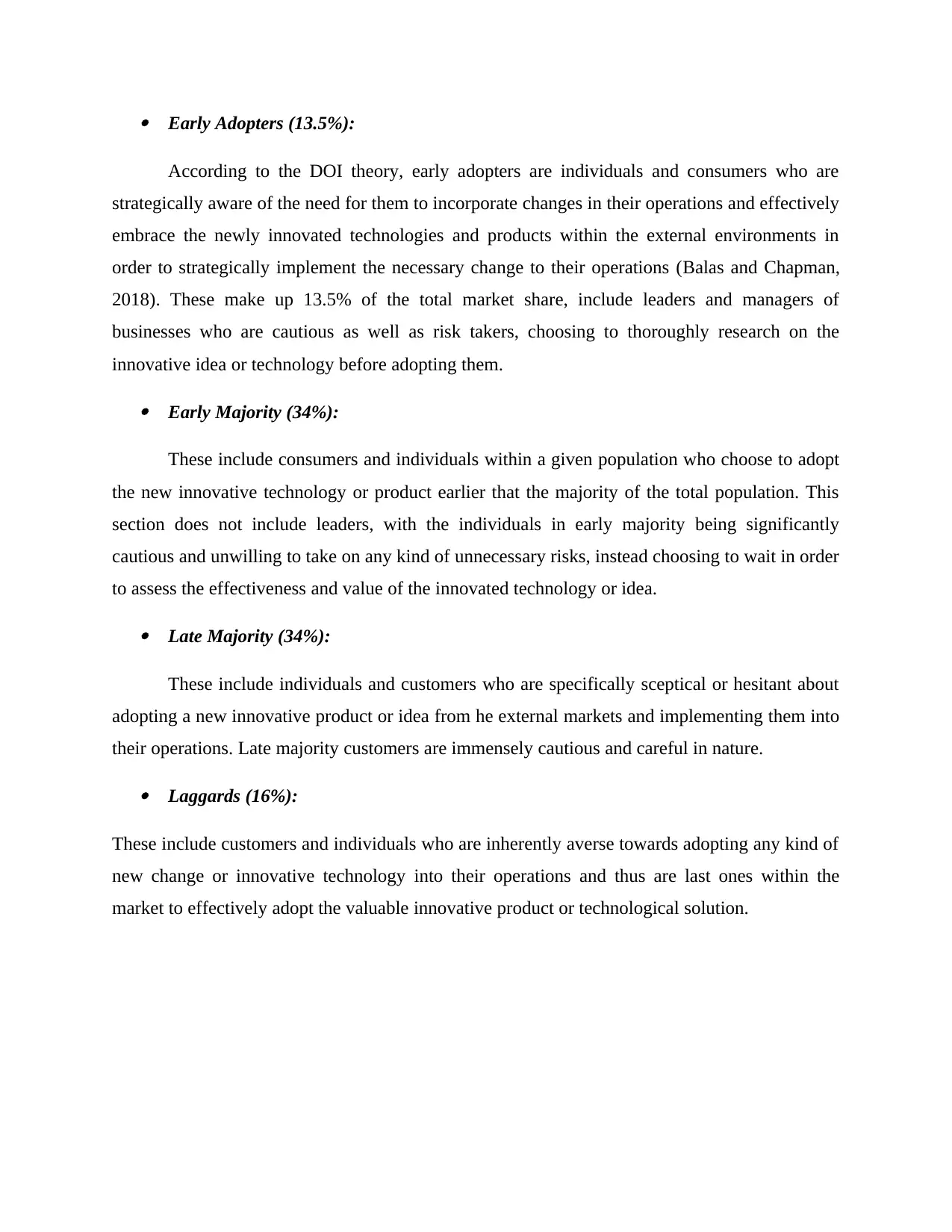
Early Adopters (13.5%):
According to the DOI theory, early adopters are individuals and consumers who are
strategically aware of the need for them to incorporate changes in their operations and effectively
embrace the newly innovated technologies and products within the external environments in
order to strategically implement the necessary change to their operations (Balas and Chapman,
2018). These make up 13.5% of the total market share, include leaders and managers of
businesses who are cautious as well as risk takers, choosing to thoroughly research on the
innovative idea or technology before adopting them.
Early Majority (34%):
These include consumers and individuals within a given population who choose to adopt
the new innovative technology or product earlier that the majority of the total population. This
section does not include leaders, with the individuals in early majority being significantly
cautious and unwilling to take on any kind of unnecessary risks, instead choosing to wait in order
to assess the effectiveness and value of the innovated technology or idea.
Late Majority (34%):
These include individuals and customers who are specifically sceptical or hesitant about
adopting a new innovative product or idea from he external markets and implementing them into
their operations. Late majority customers are immensely cautious and careful in nature.
Laggards (16%):
These include customers and individuals who are inherently averse towards adopting any kind of
new change or innovative technology into their operations and thus are last ones within the
market to effectively adopt the valuable innovative product or technological solution.
According to the DOI theory, early adopters are individuals and consumers who are
strategically aware of the need for them to incorporate changes in their operations and effectively
embrace the newly innovated technologies and products within the external environments in
order to strategically implement the necessary change to their operations (Balas and Chapman,
2018). These make up 13.5% of the total market share, include leaders and managers of
businesses who are cautious as well as risk takers, choosing to thoroughly research on the
innovative idea or technology before adopting them.
Early Majority (34%):
These include consumers and individuals within a given population who choose to adopt
the new innovative technology or product earlier that the majority of the total population. This
section does not include leaders, with the individuals in early majority being significantly
cautious and unwilling to take on any kind of unnecessary risks, instead choosing to wait in order
to assess the effectiveness and value of the innovated technology or idea.
Late Majority (34%):
These include individuals and customers who are specifically sceptical or hesitant about
adopting a new innovative product or idea from he external markets and implementing them into
their operations. Late majority customers are immensely cautious and careful in nature.
Laggards (16%):
These include customers and individuals who are inherently averse towards adopting any kind of
new change or innovative technology into their operations and thus are last ones within the
market to effectively adopt the valuable innovative product or technological solution.
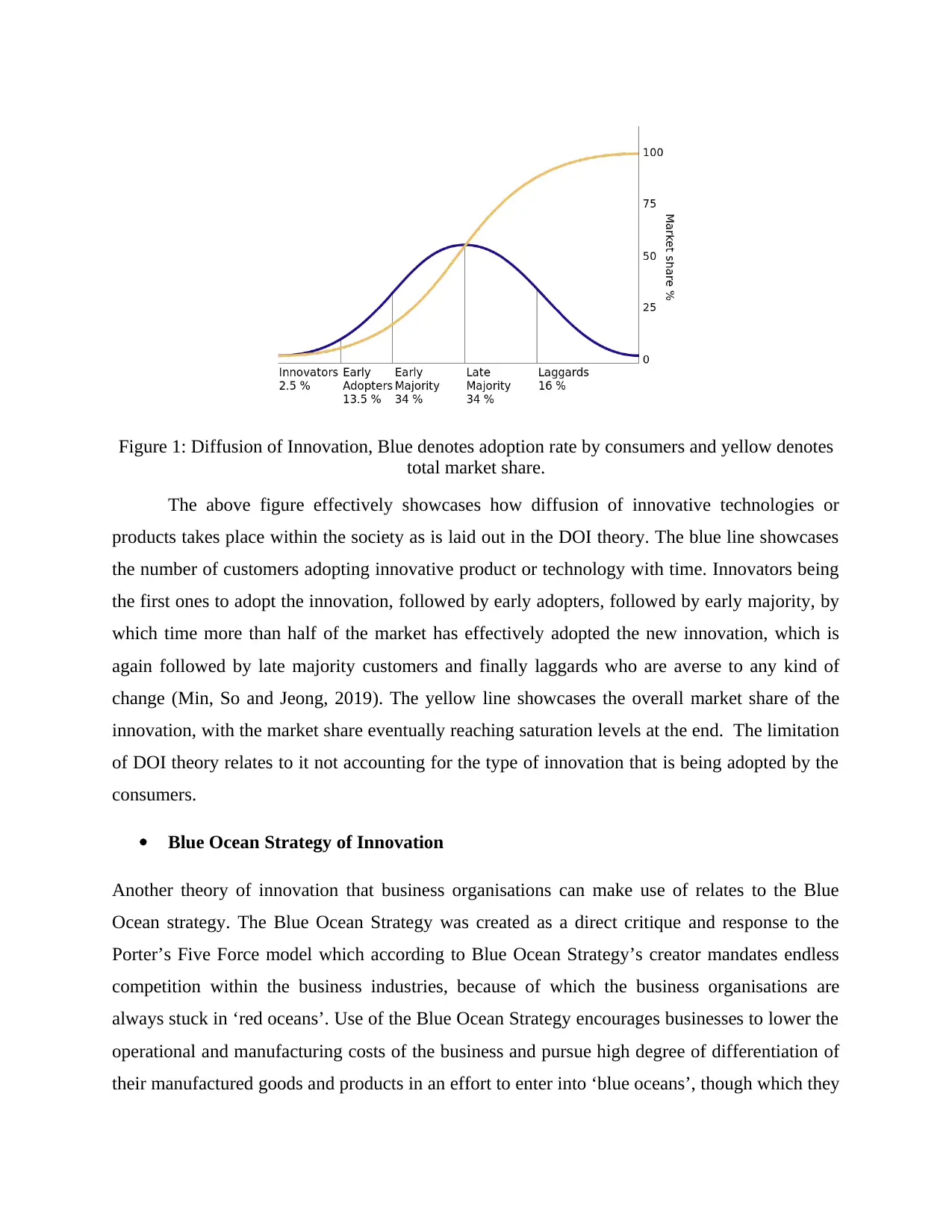
Figure 1: Diffusion of Innovation, Blue denotes adoption rate by consumers and yellow denotes
total market share.
The above figure effectively showcases how diffusion of innovative technologies or
products takes place within the society as is laid out in the DOI theory. The blue line showcases
the number of customers adopting innovative product or technology with time. Innovators being
the first ones to adopt the innovation, followed by early adopters, followed by early majority, by
which time more than half of the market has effectively adopted the new innovation, which is
again followed by late majority customers and finally laggards who are averse to any kind of
change (Min, So and Jeong, 2019). The yellow line showcases the overall market share of the
innovation, with the market share eventually reaching saturation levels at the end. The limitation
of DOI theory relates to it not accounting for the type of innovation that is being adopted by the
consumers.
Blue Ocean Strategy of Innovation
Another theory of innovation that business organisations can make use of relates to the Blue
Ocean strategy. The Blue Ocean Strategy was created as a direct critique and response to the
Porter’s Five Force model which according to Blue Ocean Strategy’s creator mandates endless
competition within the business industries, because of which the business organisations are
always stuck in ‘red oceans’. Use of the Blue Ocean Strategy encourages businesses to lower the
operational and manufacturing costs of the business and pursue high degree of differentiation of
their manufactured goods and products in an effort to enter into ‘blue oceans’, though which they
total market share.
The above figure effectively showcases how diffusion of innovative technologies or
products takes place within the society as is laid out in the DOI theory. The blue line showcases
the number of customers adopting innovative product or technology with time. Innovators being
the first ones to adopt the innovation, followed by early adopters, followed by early majority, by
which time more than half of the market has effectively adopted the new innovation, which is
again followed by late majority customers and finally laggards who are averse to any kind of
change (Min, So and Jeong, 2019). The yellow line showcases the overall market share of the
innovation, with the market share eventually reaching saturation levels at the end. The limitation
of DOI theory relates to it not accounting for the type of innovation that is being adopted by the
consumers.
Blue Ocean Strategy of Innovation
Another theory of innovation that business organisations can make use of relates to the Blue
Ocean strategy. The Blue Ocean Strategy was created as a direct critique and response to the
Porter’s Five Force model which according to Blue Ocean Strategy’s creator mandates endless
competition within the business industries, because of which the business organisations are
always stuck in ‘red oceans’. Use of the Blue Ocean Strategy encourages businesses to lower the
operational and manufacturing costs of the business and pursue high degree of differentiation of
their manufactured goods and products in an effort to enter into ‘blue oceans’, though which they
⊘ This is a preview!⊘
Do you want full access?
Subscribe today to unlock all pages.

Trusted by 1+ million students worldwide
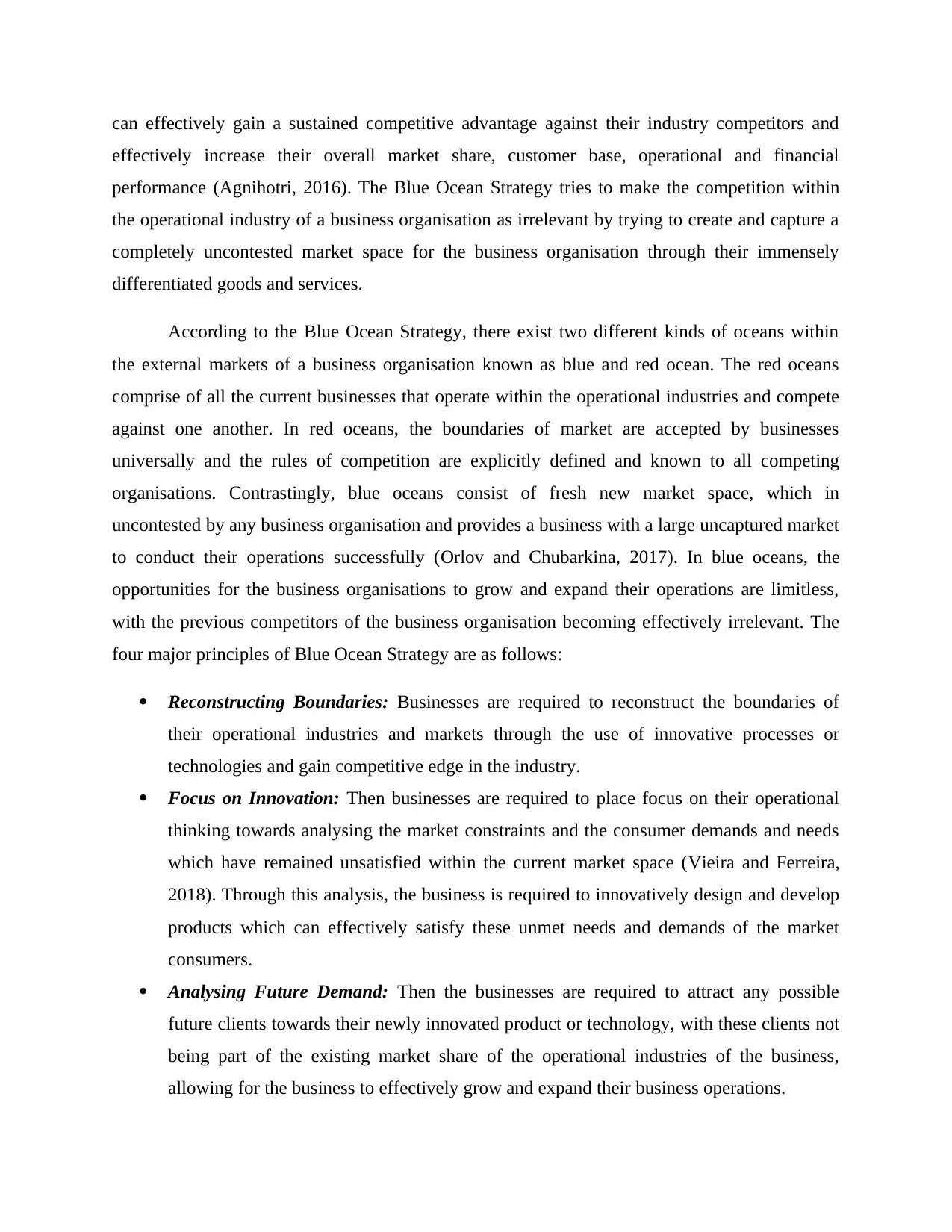
can effectively gain a sustained competitive advantage against their industry competitors and
effectively increase their overall market share, customer base, operational and financial
performance (Agnihotri, 2016). The Blue Ocean Strategy tries to make the competition within
the operational industry of a business organisation as irrelevant by trying to create and capture a
completely uncontested market space for the business organisation through their immensely
differentiated goods and services.
According to the Blue Ocean Strategy, there exist two different kinds of oceans within
the external markets of a business organisation known as blue and red ocean. The red oceans
comprise of all the current businesses that operate within the operational industries and compete
against one another. In red oceans, the boundaries of market are accepted by businesses
universally and the rules of competition are explicitly defined and known to all competing
organisations. Contrastingly, blue oceans consist of fresh new market space, which in
uncontested by any business organisation and provides a business with a large uncaptured market
to conduct their operations successfully (Orlov and Chubarkina, 2017). In blue oceans, the
opportunities for the business organisations to grow and expand their operations are limitless,
with the previous competitors of the business organisation becoming effectively irrelevant. The
four major principles of Blue Ocean Strategy are as follows:
Reconstructing Boundaries: Businesses are required to reconstruct the boundaries of
their operational industries and markets through the use of innovative processes or
technologies and gain competitive edge in the industry.
Focus on Innovation: Then businesses are required to place focus on their operational
thinking towards analysing the market constraints and the consumer demands and needs
which have remained unsatisfied within the current market space (Vieira and Ferreira,
2018). Through this analysis, the business is required to innovatively design and develop
products which can effectively satisfy these unmet needs and demands of the market
consumers.
Analysing Future Demand: Then the businesses are required to attract any possible
future clients towards their newly innovated product or technology, with these clients not
being part of the existing market share of the operational industries of the business,
allowing for the business to effectively grow and expand their business operations.
effectively increase their overall market share, customer base, operational and financial
performance (Agnihotri, 2016). The Blue Ocean Strategy tries to make the competition within
the operational industry of a business organisation as irrelevant by trying to create and capture a
completely uncontested market space for the business organisation through their immensely
differentiated goods and services.
According to the Blue Ocean Strategy, there exist two different kinds of oceans within
the external markets of a business organisation known as blue and red ocean. The red oceans
comprise of all the current businesses that operate within the operational industries and compete
against one another. In red oceans, the boundaries of market are accepted by businesses
universally and the rules of competition are explicitly defined and known to all competing
organisations. Contrastingly, blue oceans consist of fresh new market space, which in
uncontested by any business organisation and provides a business with a large uncaptured market
to conduct their operations successfully (Orlov and Chubarkina, 2017). In blue oceans, the
opportunities for the business organisations to grow and expand their operations are limitless,
with the previous competitors of the business organisation becoming effectively irrelevant. The
four major principles of Blue Ocean Strategy are as follows:
Reconstructing Boundaries: Businesses are required to reconstruct the boundaries of
their operational industries and markets through the use of innovative processes or
technologies and gain competitive edge in the industry.
Focus on Innovation: Then businesses are required to place focus on their operational
thinking towards analysing the market constraints and the consumer demands and needs
which have remained unsatisfied within the current market space (Vieira and Ferreira,
2018). Through this analysis, the business is required to innovatively design and develop
products which can effectively satisfy these unmet needs and demands of the market
consumers.
Analysing Future Demand: Then the businesses are required to attract any possible
future clients towards their newly innovated product or technology, with these clients not
being part of the existing market share of the operational industries of the business,
allowing for the business to effectively grow and expand their business operations.
Paraphrase This Document
Need a fresh take? Get an instant paraphrase of this document with our AI Paraphraser
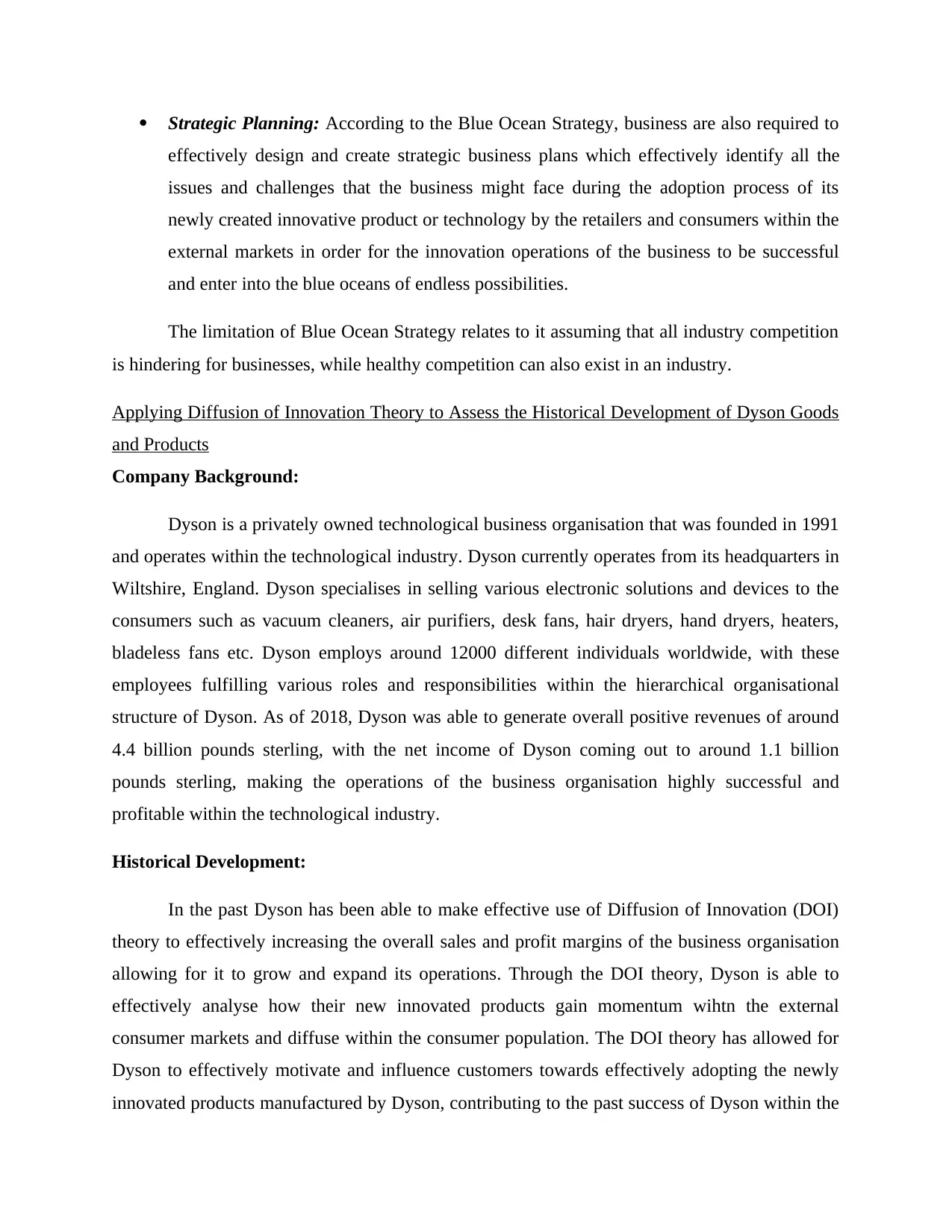
Strategic Planning: According to the Blue Ocean Strategy, business are also required to
effectively design and create strategic business plans which effectively identify all the
issues and challenges that the business might face during the adoption process of its
newly created innovative product or technology by the retailers and consumers within the
external markets in order for the innovation operations of the business to be successful
and enter into the blue oceans of endless possibilities.
The limitation of Blue Ocean Strategy relates to it assuming that all industry competition
is hindering for businesses, while healthy competition can also exist in an industry.
Applying Diffusion of Innovation Theory to Assess the Historical Development of Dyson Goods
and Products
Company Background:
Dyson is a privately owned technological business organisation that was founded in 1991
and operates within the technological industry. Dyson currently operates from its headquarters in
Wiltshire, England. Dyson specialises in selling various electronic solutions and devices to the
consumers such as vacuum cleaners, air purifiers, desk fans, hair dryers, hand dryers, heaters,
bladeless fans etc. Dyson employs around 12000 different individuals worldwide, with these
employees fulfilling various roles and responsibilities within the hierarchical organisational
structure of Dyson. As of 2018, Dyson was able to generate overall positive revenues of around
4.4 billion pounds sterling, with the net income of Dyson coming out to around 1.1 billion
pounds sterling, making the operations of the business organisation highly successful and
profitable within the technological industry.
Historical Development:
In the past Dyson has been able to make effective use of Diffusion of Innovation (DOI)
theory to effectively increasing the overall sales and profit margins of the business organisation
allowing for it to grow and expand its operations. Through the DOI theory, Dyson is able to
effectively analyse how their new innovated products gain momentum wihtn the external
consumer markets and diffuse within the consumer population. The DOI theory has allowed for
Dyson to effectively motivate and influence customers towards effectively adopting the newly
innovated products manufactured by Dyson, contributing to the past success of Dyson within the
effectively design and create strategic business plans which effectively identify all the
issues and challenges that the business might face during the adoption process of its
newly created innovative product or technology by the retailers and consumers within the
external markets in order for the innovation operations of the business to be successful
and enter into the blue oceans of endless possibilities.
The limitation of Blue Ocean Strategy relates to it assuming that all industry competition
is hindering for businesses, while healthy competition can also exist in an industry.
Applying Diffusion of Innovation Theory to Assess the Historical Development of Dyson Goods
and Products
Company Background:
Dyson is a privately owned technological business organisation that was founded in 1991
and operates within the technological industry. Dyson currently operates from its headquarters in
Wiltshire, England. Dyson specialises in selling various electronic solutions and devices to the
consumers such as vacuum cleaners, air purifiers, desk fans, hair dryers, hand dryers, heaters,
bladeless fans etc. Dyson employs around 12000 different individuals worldwide, with these
employees fulfilling various roles and responsibilities within the hierarchical organisational
structure of Dyson. As of 2018, Dyson was able to generate overall positive revenues of around
4.4 billion pounds sterling, with the net income of Dyson coming out to around 1.1 billion
pounds sterling, making the operations of the business organisation highly successful and
profitable within the technological industry.
Historical Development:
In the past Dyson has been able to make effective use of Diffusion of Innovation (DOI)
theory to effectively increasing the overall sales and profit margins of the business organisation
allowing for it to grow and expand its operations. Through the DOI theory, Dyson is able to
effectively analyse how their new innovated products gain momentum wihtn the external
consumer markets and diffuse within the consumer population. The DOI theory has allowed for
Dyson to effectively motivate and influence customers towards effectively adopting the newly
innovated products manufactured by Dyson, contributing to the past success of Dyson within the
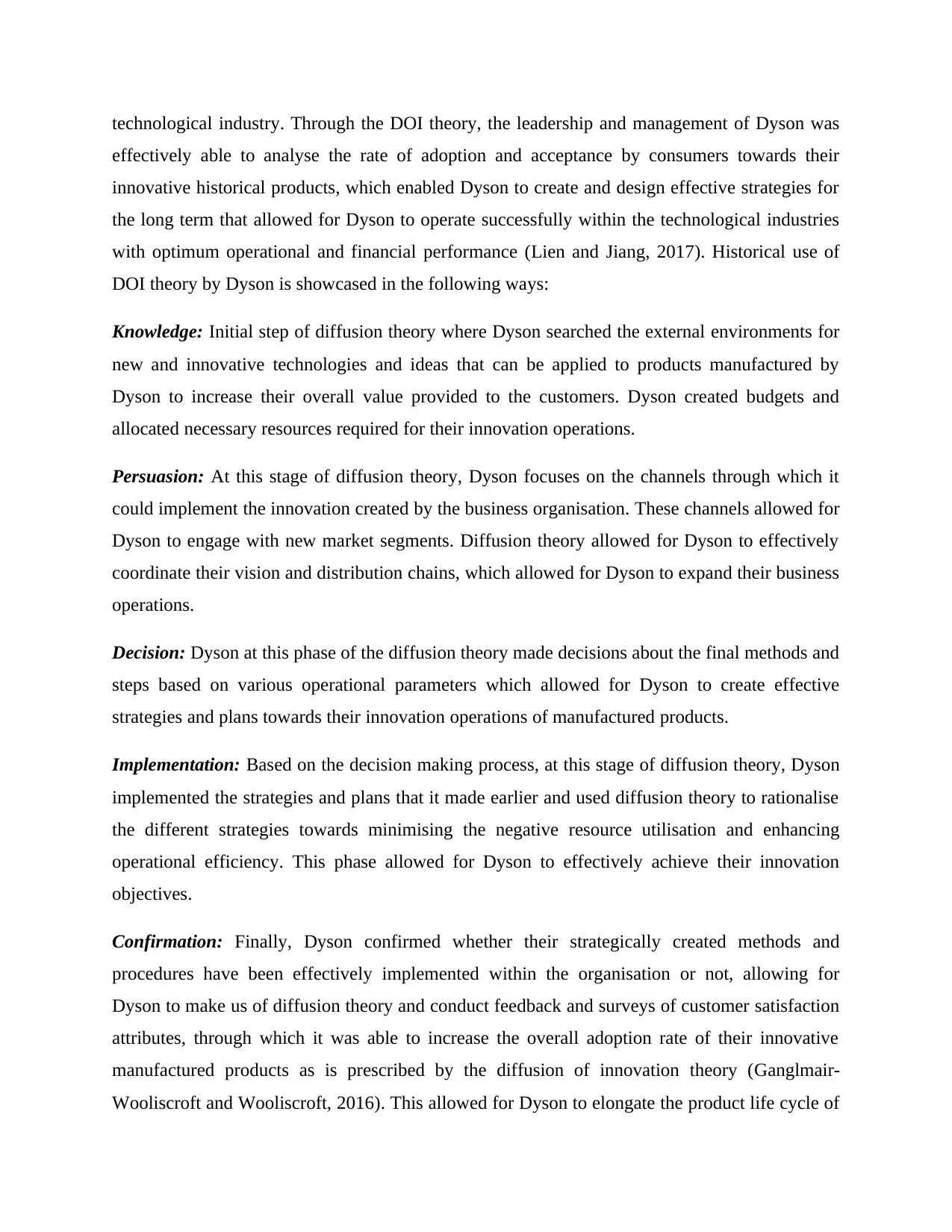
technological industry. Through the DOI theory, the leadership and management of Dyson was
effectively able to analyse the rate of adoption and acceptance by consumers towards their
innovative historical products, which enabled Dyson to create and design effective strategies for
the long term that allowed for Dyson to operate successfully within the technological industries
with optimum operational and financial performance (Lien and Jiang, 2017). Historical use of
DOI theory by Dyson is showcased in the following ways:
Knowledge: Initial step of diffusion theory where Dyson searched the external environments for
new and innovative technologies and ideas that can be applied to products manufactured by
Dyson to increase their overall value provided to the customers. Dyson created budgets and
allocated necessary resources required for their innovation operations.
Persuasion: At this stage of diffusion theory, Dyson focuses on the channels through which it
could implement the innovation created by the business organisation. These channels allowed for
Dyson to engage with new market segments. Diffusion theory allowed for Dyson to effectively
coordinate their vision and distribution chains, which allowed for Dyson to expand their business
operations.
Decision: Dyson at this phase of the diffusion theory made decisions about the final methods and
steps based on various operational parameters which allowed for Dyson to create effective
strategies and plans towards their innovation operations of manufactured products.
Implementation: Based on the decision making process, at this stage of diffusion theory, Dyson
implemented the strategies and plans that it made earlier and used diffusion theory to rationalise
the different strategies towards minimising the negative resource utilisation and enhancing
operational efficiency. This phase allowed for Dyson to effectively achieve their innovation
objectives.
Confirmation: Finally, Dyson confirmed whether their strategically created methods and
procedures have been effectively implemented within the organisation or not, allowing for
Dyson to make us of diffusion theory and conduct feedback and surveys of customer satisfaction
attributes, through which it was able to increase the overall adoption rate of their innovative
manufactured products as is prescribed by the diffusion of innovation theory (Ganglmair-
Wooliscroft and Wooliscroft, 2016). This allowed for Dyson to elongate the product life cycle of
effectively able to analyse the rate of adoption and acceptance by consumers towards their
innovative historical products, which enabled Dyson to create and design effective strategies for
the long term that allowed for Dyson to operate successfully within the technological industries
with optimum operational and financial performance (Lien and Jiang, 2017). Historical use of
DOI theory by Dyson is showcased in the following ways:
Knowledge: Initial step of diffusion theory where Dyson searched the external environments for
new and innovative technologies and ideas that can be applied to products manufactured by
Dyson to increase their overall value provided to the customers. Dyson created budgets and
allocated necessary resources required for their innovation operations.
Persuasion: At this stage of diffusion theory, Dyson focuses on the channels through which it
could implement the innovation created by the business organisation. These channels allowed for
Dyson to engage with new market segments. Diffusion theory allowed for Dyson to effectively
coordinate their vision and distribution chains, which allowed for Dyson to expand their business
operations.
Decision: Dyson at this phase of the diffusion theory made decisions about the final methods and
steps based on various operational parameters which allowed for Dyson to create effective
strategies and plans towards their innovation operations of manufactured products.
Implementation: Based on the decision making process, at this stage of diffusion theory, Dyson
implemented the strategies and plans that it made earlier and used diffusion theory to rationalise
the different strategies towards minimising the negative resource utilisation and enhancing
operational efficiency. This phase allowed for Dyson to effectively achieve their innovation
objectives.
Confirmation: Finally, Dyson confirmed whether their strategically created methods and
procedures have been effectively implemented within the organisation or not, allowing for
Dyson to make us of diffusion theory and conduct feedback and surveys of customer satisfaction
attributes, through which it was able to increase the overall adoption rate of their innovative
manufactured products as is prescribed by the diffusion of innovation theory (Ganglmair-
Wooliscroft and Wooliscroft, 2016). This allowed for Dyson to elongate the product life cycle of
⊘ This is a preview!⊘
Do you want full access?
Subscribe today to unlock all pages.

Trusted by 1+ million students worldwide
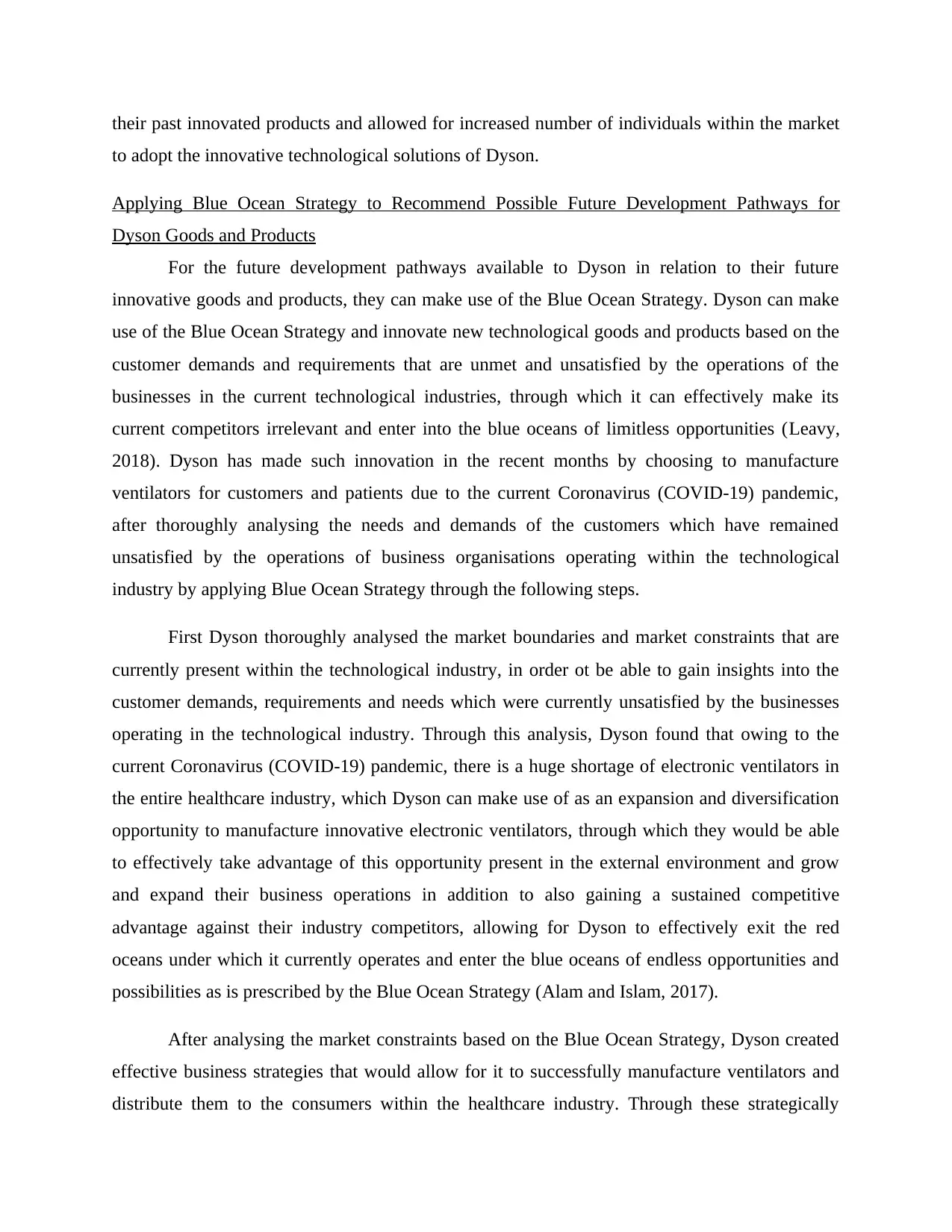
their past innovated products and allowed for increased number of individuals within the market
to adopt the innovative technological solutions of Dyson.
Applying Blue Ocean Strategy to Recommend Possible Future Development Pathways for
Dyson Goods and Products
For the future development pathways available to Dyson in relation to their future
innovative goods and products, they can make use of the Blue Ocean Strategy. Dyson can make
use of the Blue Ocean Strategy and innovate new technological goods and products based on the
customer demands and requirements that are unmet and unsatisfied by the operations of the
businesses in the current technological industries, through which it can effectively make its
current competitors irrelevant and enter into the blue oceans of limitless opportunities (Leavy,
2018). Dyson has made such innovation in the recent months by choosing to manufacture
ventilators for customers and patients due to the current Coronavirus (COVID-19) pandemic,
after thoroughly analysing the needs and demands of the customers which have remained
unsatisfied by the operations of business organisations operating within the technological
industry by applying Blue Ocean Strategy through the following steps.
First Dyson thoroughly analysed the market boundaries and market constraints that are
currently present within the technological industry, in order ot be able to gain insights into the
customer demands, requirements and needs which were currently unsatisfied by the businesses
operating in the technological industry. Through this analysis, Dyson found that owing to the
current Coronavirus (COVID-19) pandemic, there is a huge shortage of electronic ventilators in
the entire healthcare industry, which Dyson can make use of as an expansion and diversification
opportunity to manufacture innovative electronic ventilators, through which they would be able
to effectively take advantage of this opportunity present in the external environment and grow
and expand their business operations in addition to also gaining a sustained competitive
advantage against their industry competitors, allowing for Dyson to effectively exit the red
oceans under which it currently operates and enter the blue oceans of endless opportunities and
possibilities as is prescribed by the Blue Ocean Strategy (Alam and Islam, 2017).
After analysing the market constraints based on the Blue Ocean Strategy, Dyson created
effective business strategies that would allow for it to successfully manufacture ventilators and
distribute them to the consumers within the healthcare industry. Through these strategically
to adopt the innovative technological solutions of Dyson.
Applying Blue Ocean Strategy to Recommend Possible Future Development Pathways for
Dyson Goods and Products
For the future development pathways available to Dyson in relation to their future
innovative goods and products, they can make use of the Blue Ocean Strategy. Dyson can make
use of the Blue Ocean Strategy and innovate new technological goods and products based on the
customer demands and requirements that are unmet and unsatisfied by the operations of the
businesses in the current technological industries, through which it can effectively make its
current competitors irrelevant and enter into the blue oceans of limitless opportunities (Leavy,
2018). Dyson has made such innovation in the recent months by choosing to manufacture
ventilators for customers and patients due to the current Coronavirus (COVID-19) pandemic,
after thoroughly analysing the needs and demands of the customers which have remained
unsatisfied by the operations of business organisations operating within the technological
industry by applying Blue Ocean Strategy through the following steps.
First Dyson thoroughly analysed the market boundaries and market constraints that are
currently present within the technological industry, in order ot be able to gain insights into the
customer demands, requirements and needs which were currently unsatisfied by the businesses
operating in the technological industry. Through this analysis, Dyson found that owing to the
current Coronavirus (COVID-19) pandemic, there is a huge shortage of electronic ventilators in
the entire healthcare industry, which Dyson can make use of as an expansion and diversification
opportunity to manufacture innovative electronic ventilators, through which they would be able
to effectively take advantage of this opportunity present in the external environment and grow
and expand their business operations in addition to also gaining a sustained competitive
advantage against their industry competitors, allowing for Dyson to effectively exit the red
oceans under which it currently operates and enter the blue oceans of endless opportunities and
possibilities as is prescribed by the Blue Ocean Strategy (Alam and Islam, 2017).
After analysing the market constraints based on the Blue Ocean Strategy, Dyson created
effective business strategies that would allow for it to successfully manufacture ventilators and
distribute them to the consumers within the healthcare industry. Through these strategically
Paraphrase This Document
Need a fresh take? Get an instant paraphrase of this document with our AI Paraphraser
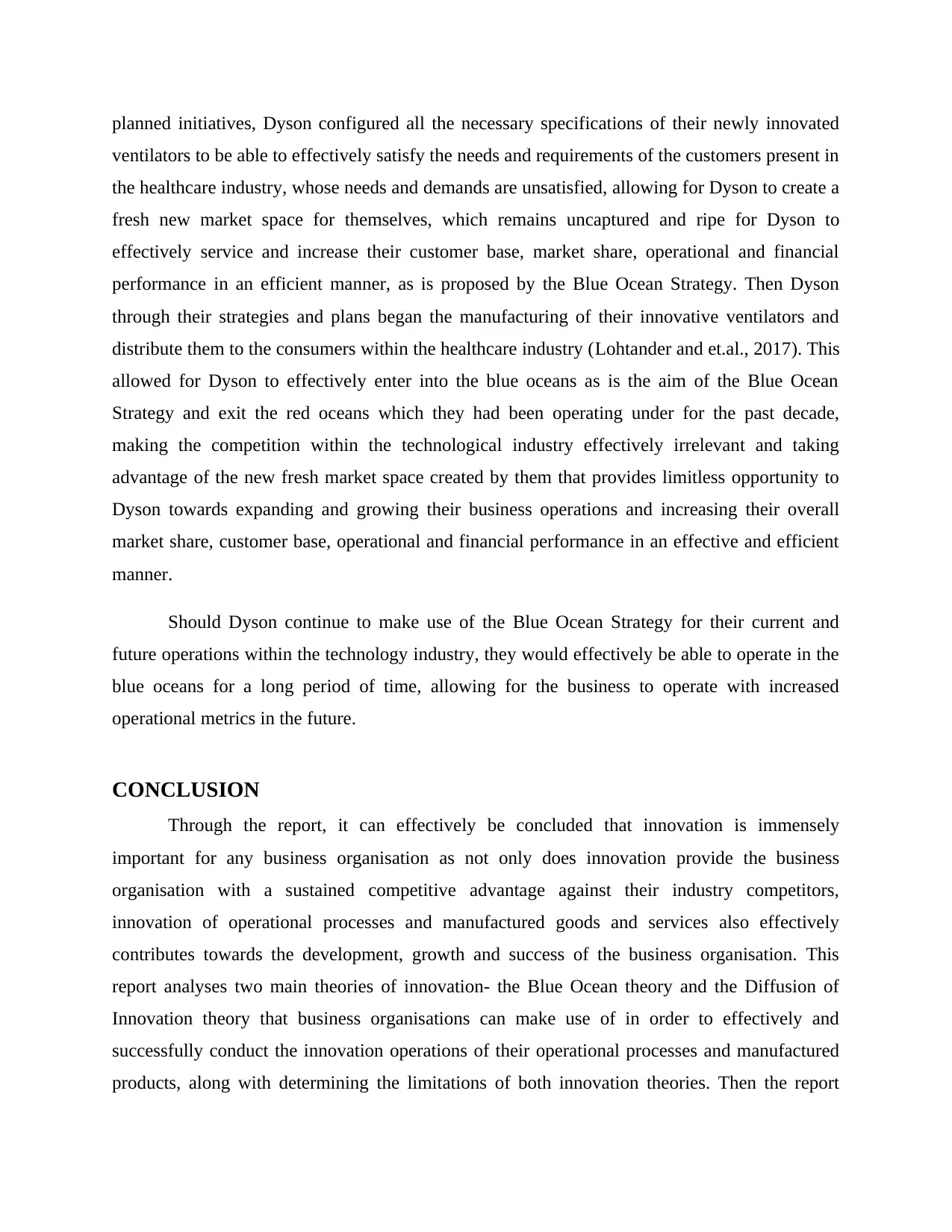
planned initiatives, Dyson configured all the necessary specifications of their newly innovated
ventilators to be able to effectively satisfy the needs and requirements of the customers present in
the healthcare industry, whose needs and demands are unsatisfied, allowing for Dyson to create a
fresh new market space for themselves, which remains uncaptured and ripe for Dyson to
effectively service and increase their customer base, market share, operational and financial
performance in an efficient manner, as is proposed by the Blue Ocean Strategy. Then Dyson
through their strategies and plans began the manufacturing of their innovative ventilators and
distribute them to the consumers within the healthcare industry (Lohtander and et.al., 2017). This
allowed for Dyson to effectively enter into the blue oceans as is the aim of the Blue Ocean
Strategy and exit the red oceans which they had been operating under for the past decade,
making the competition within the technological industry effectively irrelevant and taking
advantage of the new fresh market space created by them that provides limitless opportunity to
Dyson towards expanding and growing their business operations and increasing their overall
market share, customer base, operational and financial performance in an effective and efficient
manner.
Should Dyson continue to make use of the Blue Ocean Strategy for their current and
future operations within the technology industry, they would effectively be able to operate in the
blue oceans for a long period of time, allowing for the business to operate with increased
operational metrics in the future.
CONCLUSION
Through the report, it can effectively be concluded that innovation is immensely
important for any business organisation as not only does innovation provide the business
organisation with a sustained competitive advantage against their industry competitors,
innovation of operational processes and manufactured goods and services also effectively
contributes towards the development, growth and success of the business organisation. This
report analyses two main theories of innovation- the Blue Ocean theory and the Diffusion of
Innovation theory that business organisations can make use of in order to effectively and
successfully conduct the innovation operations of their operational processes and manufactured
products, along with determining the limitations of both innovation theories. Then the report
ventilators to be able to effectively satisfy the needs and requirements of the customers present in
the healthcare industry, whose needs and demands are unsatisfied, allowing for Dyson to create a
fresh new market space for themselves, which remains uncaptured and ripe for Dyson to
effectively service and increase their customer base, market share, operational and financial
performance in an efficient manner, as is proposed by the Blue Ocean Strategy. Then Dyson
through their strategies and plans began the manufacturing of their innovative ventilators and
distribute them to the consumers within the healthcare industry (Lohtander and et.al., 2017). This
allowed for Dyson to effectively enter into the blue oceans as is the aim of the Blue Ocean
Strategy and exit the red oceans which they had been operating under for the past decade,
making the competition within the technological industry effectively irrelevant and taking
advantage of the new fresh market space created by them that provides limitless opportunity to
Dyson towards expanding and growing their business operations and increasing their overall
market share, customer base, operational and financial performance in an effective and efficient
manner.
Should Dyson continue to make use of the Blue Ocean Strategy for their current and
future operations within the technology industry, they would effectively be able to operate in the
blue oceans for a long period of time, allowing for the business to operate with increased
operational metrics in the future.
CONCLUSION
Through the report, it can effectively be concluded that innovation is immensely
important for any business organisation as not only does innovation provide the business
organisation with a sustained competitive advantage against their industry competitors,
innovation of operational processes and manufactured goods and services also effectively
contributes towards the development, growth and success of the business organisation. This
report analyses two main theories of innovation- the Blue Ocean theory and the Diffusion of
Innovation theory that business organisations can make use of in order to effectively and
successfully conduct the innovation operations of their operational processes and manufactured
products, along with determining the limitations of both innovation theories. Then the report
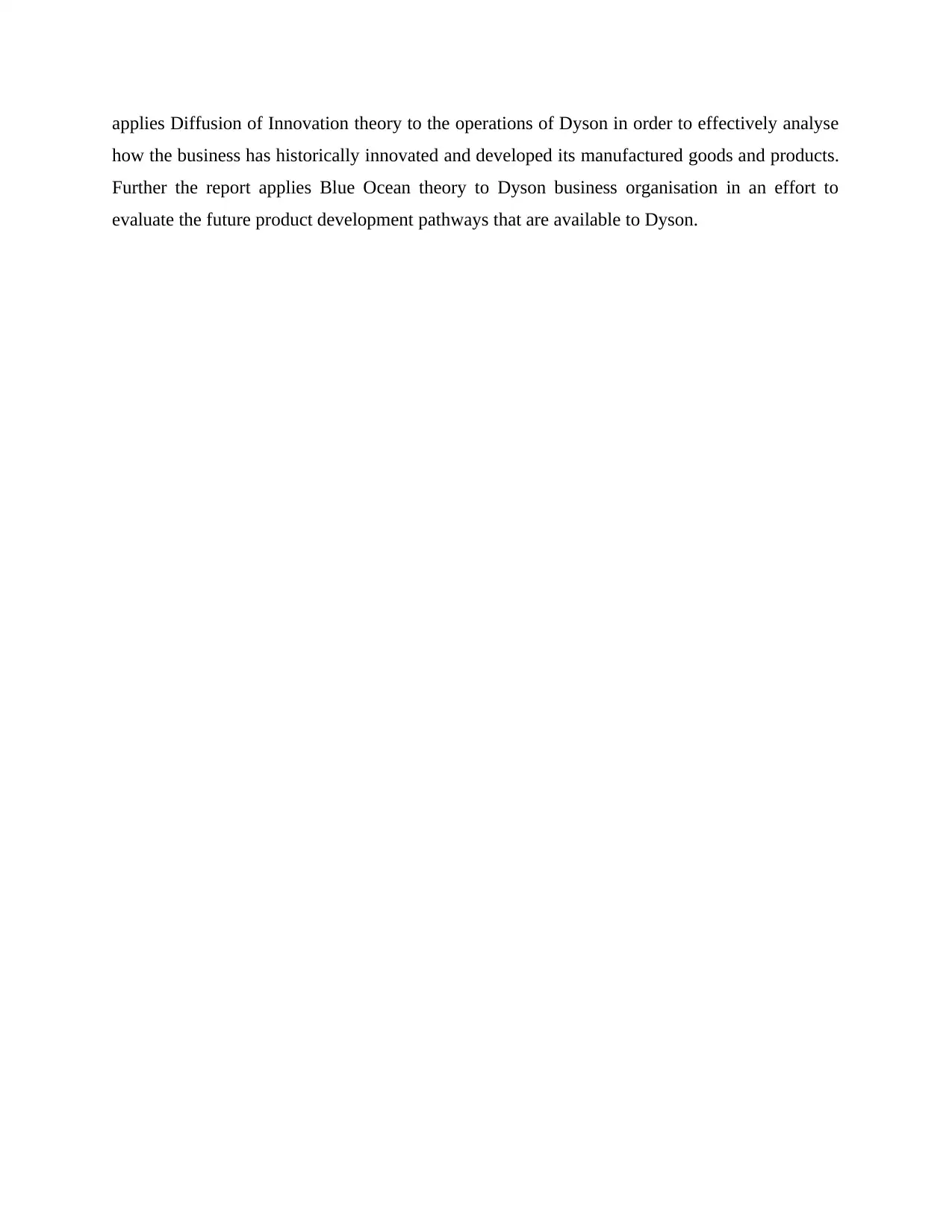
applies Diffusion of Innovation theory to the operations of Dyson in order to effectively analyse
how the business has historically innovated and developed its manufactured goods and products.
Further the report applies Blue Ocean theory to Dyson business organisation in an effort to
evaluate the future product development pathways that are available to Dyson.
how the business has historically innovated and developed its manufactured goods and products.
Further the report applies Blue Ocean theory to Dyson business organisation in an effort to
evaluate the future product development pathways that are available to Dyson.
⊘ This is a preview!⊘
Do you want full access?
Subscribe today to unlock all pages.

Trusted by 1+ million students worldwide
1 out of 13
Related Documents
Your All-in-One AI-Powered Toolkit for Academic Success.
+13062052269
info@desklib.com
Available 24*7 on WhatsApp / Email
![[object Object]](/_next/static/media/star-bottom.7253800d.svg)
Unlock your academic potential
Copyright © 2020–2025 A2Z Services. All Rights Reserved. Developed and managed by ZUCOL.





